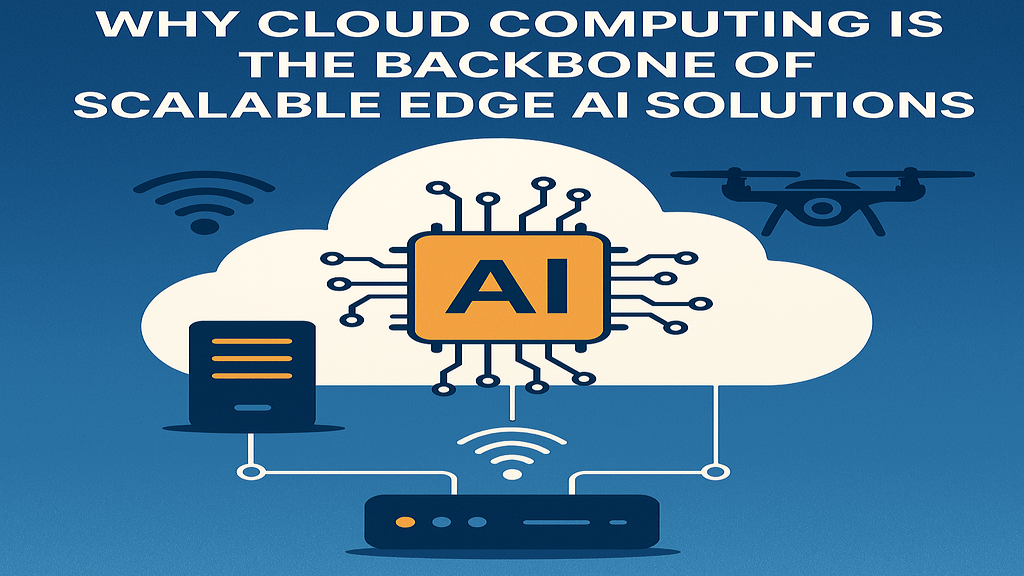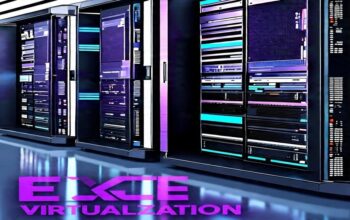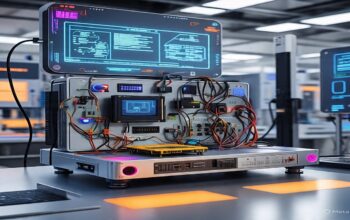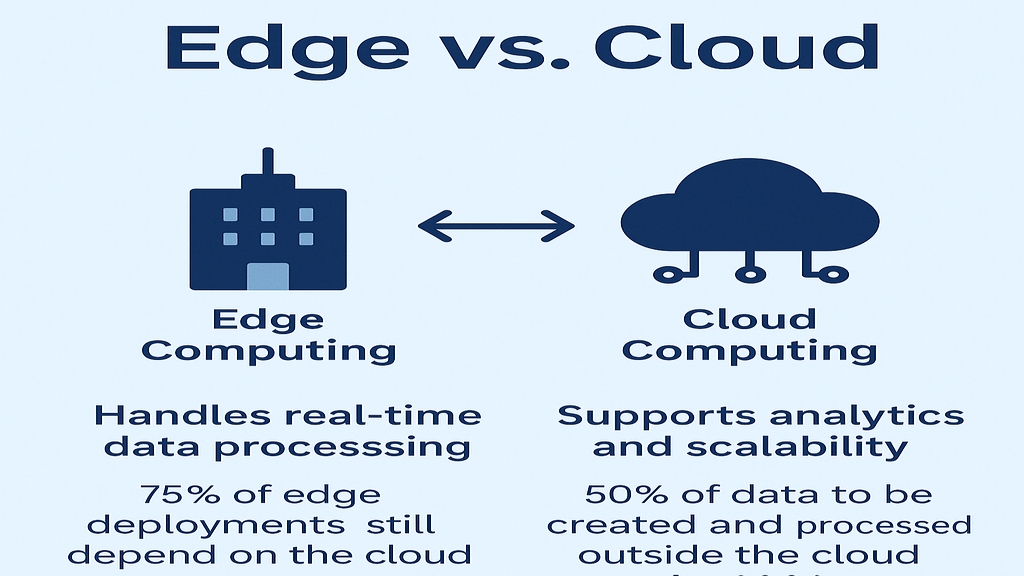Covered Contents
ToggleINTRODUCTION
Cloud computing and edge artificial intelligence (Edge AI) transform industries from manufacturing to healthcare by enabling real-time decision-making without sacrificing scalability. While cloud computing provides the framework to train, improve, and scale these AI models globally, Edge AI manages data locally on devices like sensors or drones. For businesses hoping to stay competitive in the era of exponential data proliferation, this synergy is more than just a technological advancement. Let’s discuss why achieving Edge AI’s full potential requires cloud computing.
What Is Cloud Computing?
To store data and run programs online, cloud computing uses distant servers. Instead of spending money on hardware, businesses can use scalable resources from suppliers like Microsoft, Google, and Amazon. Because of the model’s flexibility, affordability, and processing capacity, businesses can handle massive data volumes and complex AI model training without having to make significant upfront investments.
What Is Edge AI?
Edge AI runs artificial intelligence algorithms directly on local devices such as sensors, smartphones, or cameras. Learn More about Edge AI:
What Is Edge AI? How It Works, Types, and Applications
The Integration of Cloud Computing and Edge AI
Lean and responsive systems are created by combining the capabilities of cloud computing and edge artificial intelligence (AI). While edge AI enables real-time data processing on local devices, cloud computing offers scalable resources for training complex AI models on massive datasets. Combining the two allows for immediate edge decision-making, while cloud-based analytics and model fine-tuning facilitate ongoing updates and improvements. This partnership reduces latency, boosts speed, and keeps AI systems flexible enough to adjust to shifting consumer needs and data.
Cloud Performs Model Training and Heavy Computation
The cloud provides the massive computer resources needed for AI model training. Using strong hardware like H200 GPUs can drastically cut down on the amount of time needed to train models. For example, compared to traditional on-premise deployments, Google’s cloud-based systems can train models ten times quicker. These speeds are essential for industries like banking, healthcare, and driverless cars, where AI models must continuously evolve to deliver effective outcomes in real time.
Scalability
Scalability is one of the main advantages of the cloud. Dynamic resource allocation made possible by cloud architecture makes it simple to increase processing power when data volumes spike. Cloud computing, which has data centers all over the world, ensures that edge devices have access to the newest models and sufficient processing power, allowing for growth without requiring a major overhaul of the infrastructure.
Adaptability and Flexibility
Due to its ability to enable smooth software updates and smooth integration with numerous IoT devices, cloud computing is flexible. Developers can prototype new models in the cloud before rolling out the top-performing AI model to edge devices. This flexibility ensures that systems are flexible enough to accommodate changing consumer needs and technological advancements.
Privacy and Security
Security is enhanced by the integration of cloud and edge computing. Through local management of personal data, Edge AI reduces the threat of security violations during transit. On the other hand, Cloud providers invest in secure practices such as firewalls, encryption, and stringent access controls. Sectors dealing with sensitive information and need to comply with legal requirements such as HIPAA and GDPR need to implement this multi-layered security solution.
Efficiency and Cost Savings
It will be costly to execute complicated AI models on every edge device. Cloud computing reduces these expenses through complex computations. Because only the most important data is sent to the cloud. This saves bandwidth and lowers the number of high-capacity hardware components per edge device. All things considered, a hybrid approach like this saves a lot of money and energy.
Security: A Shared Responsibility Between Edge and Cloud
A Joint Obligation Between Cloud Edge and Edge By keeping private data (such as patient vitals) on-device, AI improves privacy. However, the cloud offers extra security measures. Cloud platforms offer capabilities for regulatory compliance, including GDPR and HIPAA, as well as military-grade encryption. Healthcare wearables, for example, employ the cloud for safe auditing and storage while computing locally. A breakthrough known as federated learning enables edge devices to train models locally. Only model updates (not raw data) are uploaded to the cloud, with privacy versus collective intelligence balanced.
Cost Efficiency: Edge + Cloud = Savings
Without the cloud, Edge AI deployment would be like constructing a freeway without rest areas. Scalability diminishes, and initial costs skyrocket. Training a single AI model internally can cost more than $100K. Cloud providers enable startups to access cutting-edge AI by distributing these expenses among clients. Cloud-based AI accelerators, such as H200 GPUs, are available from companies like NVIDIA, allowing companies to rent power rather than purchase pricey hardware. Cloud analytics helps refine these models over time, but edge-predictive maintenance reduces downtime expenses for companies by 20%.
The Future: Sustainability, Democratized AI, and 5G
Cloud-edge communication in real time is made possible by faster 5G networks. Assume that drones examine electrical lines: the cloud records damage across districts, and Edge AI avoids obstructions. Cloud platforms like Azure IoT Edge enable developers to install pre-trained AI models on affordable devices. This technology is already being utilized in small farms and neighborhood clinics. Additionally, hybrid systems save electricity. For example, the cloud improves national distribution, and smart grids use Edge AI to regulate local energy needs.
Real-World Applications
Autonomous Vehicles: AI models developed in the cloud are installed in vehicles to evaluate sensor data in real time, enabling quicker reactions and increased safety while driving.
Health Monitoring: Cloud computing continuously refines the models from massive patient information, while wearables and smart sensors use edge AI to spot abnormalities instantly.
Smart Cities: Local data from sensors and traffic lights is analyzed by edge devices, and the cloud aggregates the data to guide urban planning.
Industrial Automation: Factories use Edge AI to keep an eye on machinery, predict malfunctions, efficiently plan maintenance, reduce downtime, and boost output.
Retail & E-commerce: Storefront sensors provide real-time information for personal shopping experiences, and the cloud trains models to handle inventories and predict trends.
Security Systems: Edge AI in security cameras allows real-time threat detection using the cloud to train advanced models for facial recognition and anomaly detection.
Challenges to Overcome
The convergence of edge and cloud is expertise-intensive. AWS IoT Greengrass makes it easy but requires expert teams. Every edge device is a potential security vulnerability, so zero-trust architecture and frequent updates are essential. Although the cloud is cheaper in the long run, data transfer charges can be cumulative. Edge preprocessing (preprocessing data before uploading) saves costs.
Conclusion
The brain and nervous system of modern technology are edge AI and cloud computing. While one learns, adapts, and scales, the other controls reflexes in the moment. By 2025, industries will be creating 75% of their data at the edge, making them even more dependent on one another. The lesson for businesses is clear: Use both cloud and edge instead of having to choose between the two. Those who use the cloud’s scalability to enable Edge AI’s speed will have the future. This collaboration is not just inventive but also necessary, whether it is enabling self-driving cars or saving lives in hospitals.
Learn More:
Mobile vs. Cloud Computing: Benefits, Challenges, and Applications




One thought on “Why Cloud Computing is the Backbone of Scalable Edge AI Solutions”